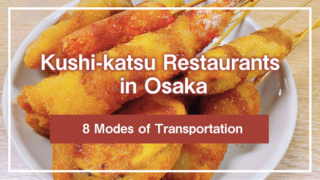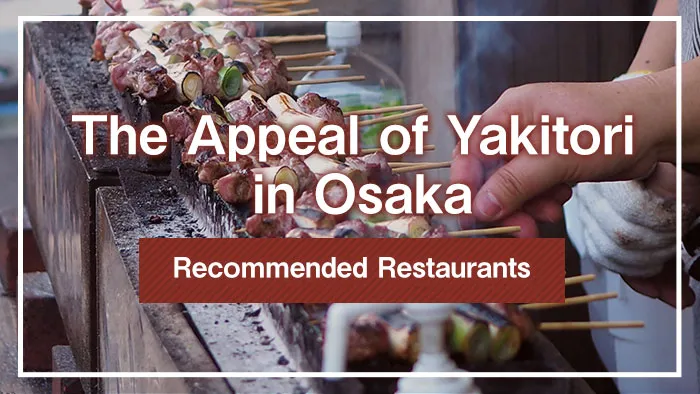Yakitori culture is deeply rooted in Japan.
Yakitori is a dish where various chicken parts are cut into bite-sized pieces, skewered, and cooked over charcoal. In Japan, izakayas that mainly serve yakitori are prevalent, establishing the genre known as “yakitori shops.” One of the most notable features of these shops is that they offer enjoyable experiences at reasonable prices.
In this article, we will provide a comprehensive guide that covers everything from how to eat yakitori and its main types to highly-rated yakitori restaurants located in the major areas of Osaka, the largest city in the Kansai region. Whether you’re planning a trip to Osaka or looking for delicious yakitori restaurants in the area, this guide is for you.
1.What is Yakitori?
Yakitori is a Japanese dish made by cutting various parts of chicken into bite-sized pieces, skewering them, and thoroughly grilling them over charcoal. It is an extremely popular dish in Japan, sold everywhere from festival food stalls to the hot food sections of convenience stores.
For those who want to enjoy authentic yakitori in Japan, it is recommended to visit izakayas that specialize in yakitori. These establishments are not referred to as “Izakaya” by the Japanese but rather as “Yakitoriten” or “Yakitoriyasan,” both terms specifically denoting yakitori restaurants.
Thus, within the category of izakayas, the specific term for places that specialize in yakitori shows just how iconic and popular the combination of “izakaya” and “yakitori” is in Japan.
1-1.How to Eat Yakitori
At izakayas, yakitori can be ordered individually by the skewer or as an assortment of different types. When enjoying yakitori, it’s important not to forget to adhere to certain unique etiquettes.
There are two methods for eating yakitori: one involves using chopsticks to pull the chicken off the skewers onto a plate before eating each piece individually with the chopsticks; the other is eating directly from the skewers. While many Japanese, who are accustomed to yakitori culture, prefer the first method using chopsticks, eating directly from the skewers is considered the best way to enjoy the unique flavor of freshly grilled yakitori.
After eating the skewered chicken, the remaining skewers should be placed in an empty cup, typically found next to the chopstick holder or condiments on the table. In Japan, these dedicated cups are known as “kushiire” and are typically available on every table at yakitori establishments.
1-2.Types of Yakitori
In Japanese yakitori restaurants, the skewers are primarily seasoned with either a sauce known as “tare,” made from soy sauce, mirin (a type of rice wine), and sugar, or simply with salt to allow the natural flavors of the ingredients to shine through. Yakitori aficionados in Japan typically choose the seasoning based on the type of yakitori, or specifically the cut of chicken.
Here’s a guide to the types of yakitori, their characteristics, and recommended seasonings:
| Thigh (Momo) | This is made from the chicken’s thigh to leg area, known for its juiciness and rich flavor. Both tare and salt seasonings are popular in Japan, where it is a staple menu item. |
|---|---|
| Negima | This skewer alternates between juicy chicken thigh meat and voluminous pieces of white leek. The combination of chicken and aromatic leek can be enjoyed with either tare or salt seasoning. |
| Tsukune | These are meatballs made from minced chicken mixed with various seasonings. Typically seasoned with tare, some establishments offer them with a raw egg yolk as a popular accompaniment. |
| Skin(Kawa) | Yakitori that features only chicken skin, offering a range of textures from crispy to tender, depending on how it’s cooked at each restaurant. Both tare and salt are popular choices. |
| Sasami | Made from chicken breast, this is a relatively healthy option. While both tare and salt are commonly used, combinations like “salt and wasabi” or “salt and plum” are especially beloved. |
| Liver (Kimo) | Made from chicken liver, this skewer has a unique texture and flavor that can be divisive even among Japanese. Due to its robust flavor, salt is often preferred over tare. |
| Cartilage (Nankotsu) | This yakitori made from chicken cartilage is known for its crunchy texture. Both tare and salt seasonings are favorites. |
| Chicken Wing (Tebasaki) | Popular both in Japan and abroad, this skewer offers a combination of crispy skin and juicy meat. Salt and lemon is a particularly popular pairing. |
Additionally, Japanese yakitori shops also offer a variety of other items, including vegetables and combinations like enoki mushrooms wrapped in bacon, allowing for a diverse tasting experience.
2.Top 6 Recommended Yakitori Restaurants in Osaka
Numerous yakitori restaurants call Osaka home. Here, we introduce six recommended yakitori restaurants that are beloved by both foreign tourists and local residents alike. If you’re looking to discover delicious yakitori spots in Osaka, be sure to consider these options.
Top 12 Popular Okonomiyaki Restaurants in Osaka
Introducing the best izakayas in the Umeda, Namba, and Tennoji areas of Osaka!
2-1.やきとり 松里(Yakitori Matsuri)
“Yakitori Matsuri” is located just a three-minute walk from JR Kitashinchi Station. In 2023, it was selected as one of the top yakitori restaurants by a major gourmet review site, and it is beloved by locals as well.
The menu is exclusively course-based, allowing patrons to fully enjoy exquisite yakitori made with seasonal ingredients and abundant flavorings. Due to its high popularity, it’s best to make a reservation in advance.
2-2.炭火やきとり 雅(Sumibiyakitori Miyabi)
“Sumibiyakitori Miyabi” is a yakitori restaurant located about a ten-minute walk from Keihan’s “Kuzuha Station.” Originally situated near Tenjinbashisuji Shopping Street, a four-minute walk from Osaka Metro’s “Tanimachi Roku-chome Station,” the restaurant moved to its current location in Hirakata, Osaka, in December 2023.
Hirakata, where Kuzuha Station is located, is characterized by its local atmosphere and has fewer tourist attractions geared towards international visitors compared to areas like Umeda or the Namba-Shinsaibashi area. However, many continue to visit “Sumibiyakitori Miyabi” even after the relocation, drawn by the unique flavor and freshness of its yakitori.It is recommended for those who wish to enjoy yakitori and drinks in a quiet, less crowded setting.
2-3.車 心斎橋店(Kuruma Shinsaibashi Store)
“Kuruma Shinsaibashi Store” is a yakitori restaurant conveniently located just a minute’s walk from Osaka Metro’s “Shinsaibashi Station.” It offers a variety of authentic Japanese dishes, including yakitori, as well as Mizutaki hotpot and chicken sashimi, using original Miyazaki chicken raised in natural surroundings. The restaurant also features a selection of carefully curated delicious sake.
Kuruma Shinsaibashi Store provides a wide variety of all-you-can-drink courses lasting 2-3 hours, making it possible to enjoy a fulfilling experience even on a budget. With English menus available, foreign tourists can order with ease and confidence.
2-4.心水 大阪西梅田店(Motomi Osaka Nishi-Umeda Store)
“Motomi Osaka Nishi-Umeda Store” is a yakitori restaurant conveniently located just a minute’s walk from Osaka Metro’s “Nishi-Umeda Station” and four minutes from JR’s “Kitashinchi Station.” The owner sources the Hanao chicken and seasonal vegetables directly from his family’s poultry farm in Kagoshima.The carefully selected free-range chicken is cooked by artisans who have a deep understanding of poultry, allowing patrons to enjoy rare cuts that are seldom available elsewhere.
The restaurant also offers a wide selection of alcoholic beverages that pair well with the high-quality yakitori, and it is said to have secret drinks not listed on the menu. For those looking to enjoy yakitori with Japanese sake, shochu, or wine, Motomi is highly recommended.
2-5.やきとり松岡(Yakitori Matsuoka)
“Yakitori Matsuoka” is located a seven-minute walk from Kintetsu’s “Uehommachi Station” and Osaka Metro’s “Tanimachi Roku-chome” and “Tanimachi Kyu-chome Stations.” Here, you can thoroughly enjoy rare cuts of Kuro Satsuma chicken, meticulously grilled over rare Kishu binchotan (ubame oak) charcoal. The restaurant offers a course-only menu.
Yakitori Matsuoka has only nine seats, all arranged in a counter-style setting. Dining here provides a cozy, luxurious hideaway experience that promises to be an unforgettable part of any trip to Japan. The restaurant also offers English service, ensuring that foreign tourists can visit with ease.
2-6.あやむ屋(Ayamuya)
“Ayamuya” is a yakitori restaurant excellently located just a minute’s walk from JR “Shinfukushima Station” and Hanshin “Fukushima Station.” It is renowned as the first restaurant in Osaka to earn a Michelin star and is also featured in major gourmet review site rankings.
At Ayamuya, the chefs meticulously grill different parts of Tanba chicken over Kishu binchotan (ubame oak) charcoal, adjusting the heat to perfection. This restaurant is recommended for those who want to experience truly delicious yakitori. Due to its popularity, it’s advisable to check the availability and book online in advance.
Conclusion
Yakitori, skewered chicken grilled over charcoal, is an extremely popular dish among Japanese people. To truly enjoy authentic yakitori, it’s best to visit izakayas that specialize in yakitori.
Osaka boasts numerous izakayas (yakitori restaurants) where you can savor this dish. The type of chicken used, as well as the degree of grilling and the flavor of the charcoal, vary from one restaurant to another, adding to the charm of Japanese yakitori restaurants. Many places also offer a wide selection of alcoholic beverages and allow orders by the skewer, making it enjoyable to go on a “pub crawl” while sampling different yakitori.
*This article is based on information available as of May 2024.


























